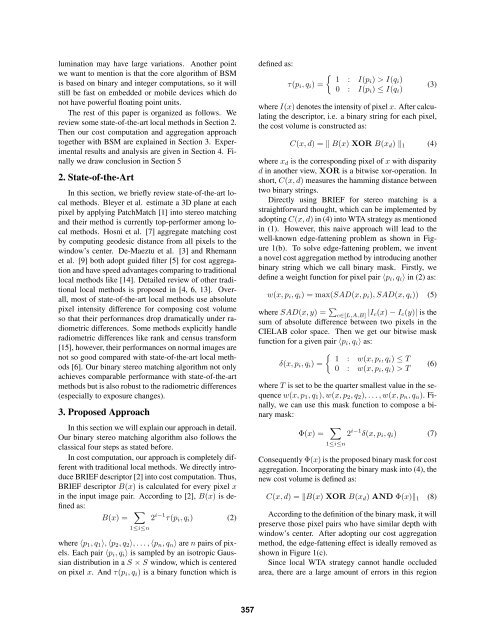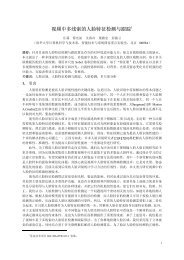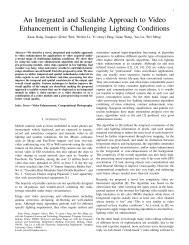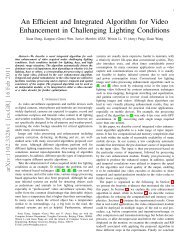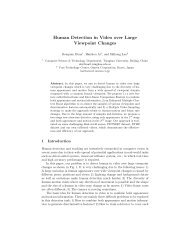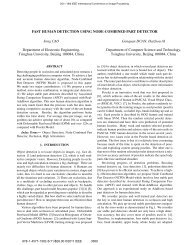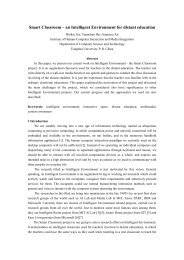Binary Stereo Matching
Binary Stereo Matching
Binary Stereo Matching
Create successful ePaper yourself
Turn your PDF publications into a flip-book with our unique Google optimized e-Paper software.
lumination may have large variations. Another point<br />
we want to mention is that the core algorithm of BSM<br />
is based on binary and integer computations, so it will<br />
still be fast on embedded or mobile devices which do<br />
not have powerful floating point units.<br />
The rest of this paper is organized as follows. We<br />
review some state-of-the-art local methods in Section 2.<br />
Then our cost computation and aggregation approach<br />
together with BSM are explained in Section 3. Experimental<br />
results and analysis are given in Section 4. Finally<br />
we draw conclusion in Section 5<br />
2. State-of-the-Art<br />
In this section, we briefly review state-of-the-art local<br />
methods. Bleyer et al. estimate a 3D plane at each<br />
pixel by applying PatchMatch [1] into stereo matching<br />
and their method is currently top-performer among local<br />
methods. Hosni et al. [7] aggregate matching cost<br />
by computing geodesic distance from all pixels to the<br />
window’s center. De-Maeztu et al. [3] and Rhemann<br />
et al. [9] both adopt guided filter [5] for cost aggregation<br />
and have speed advantages comparing to traditional<br />
local methods like [14]. Detailed review of other traditional<br />
local methods is proposed in [4, 6, 13]. Overall,<br />
most of state-of-the-art local methods use absolute<br />
pixel intensity difference for composing cost volume<br />
so that their performances drop dramatically under radiometric<br />
differences. Some methods explicitly handle<br />
radiometric differences like rank and census transform<br />
[15], however, their performances on normal images are<br />
not so good compared with state-of-the-art local methods<br />
[6]. Our binary stereo matching algorithm not only<br />
achieves comparable performance with state-of-the-art<br />
methods but is also robust to the radiometric differences<br />
(especially to exposure changes).<br />
3. Proposed Approach<br />
In this section we will explain our approach in detail.<br />
Our binary stereo matching algorithm also follows the<br />
classical four steps as stated before.<br />
In cost computation, our approach is completely different<br />
with traditional local methods. We directly introduce<br />
BRIEF descriptor [2] into cost computation. Thus,<br />
BRIEF descriptor B(x) is calculated for every pixel x<br />
in the input image pair. According to [2], B(x) is defined<br />
as:<br />
B(x) =<br />
∑<br />
2 i−1 τ(p i , q i ) (2)<br />
1≤i≤n<br />
where ⟨p 1 , q 1 ⟩, ⟨p 2 , q 2 ⟩, . . . , ⟨p n , q n ⟩ are n pairs of pixels.<br />
Each pair ⟨p i , q i ⟩ is sampled by an isotropic Gaussian<br />
distribution in a S × S window, which is centered<br />
on pixel x. And τ(p i , q i ) is a binary function which is<br />
defined as:<br />
τ(p i , q i ) =<br />
{ 1 : I(pi ) > I(q i )<br />
0 : I(p i ) ≤ I(q i )<br />
(3)<br />
where I(x) denotes the intensity of pixel x. After calculating<br />
the descriptor, i.e. a binary string for each pixel,<br />
the cost volume is constructed as:<br />
C(x, d) = ∥ B(x) XOR B(x d ) ∥ 1 (4)<br />
where x d is the corresponding pixel of x with disparity<br />
d in another view, XOR is a bitwise xor-operation. In<br />
short, C(x, d) measures the hamming distance between<br />
two binary strings.<br />
Directly using BRIEF for stereo matching is a<br />
straightforward thought, which can be implemented by<br />
adopting C(x, d) in (4) into WTA strategy as mentioned<br />
in (1). However, this naive approach will lead to the<br />
well-known edge-fattening problem as shown in Figure<br />
1(b). To solve edge-fattening problem, we invent<br />
a novel cost aggregation method by introducing another<br />
binary string which we call binary mask. Firstly, we<br />
define a weight function for pixel pair ⟨p i , q i ⟩ in (2) as:<br />
w(x, p i , q i ) = max(SAD(x, p i ), SAD(x, q i )) (5)<br />
where SAD(x, y) = ∑ c∈[L,A,B] |I c(x) − I c (y)| is the<br />
sum of absolute difference between two pixels in the<br />
CIELAB color space. Then we get our bitwise mask<br />
function for a given pair ⟨p i , q i ⟩ as:<br />
{ 1 : w(x, pi , q<br />
δ(x, p i , q i ) =<br />
i ) ≤ T<br />
(6)<br />
0 : w(x, p i , q i ) > T<br />
where T is set to be the quarter smallest value in the sequence<br />
w(x, p 1 , q 1 ), w(x, p 2 , q 2 ), . . . , w(x, p n , q n ). Finally,<br />
we can use this mask function to compose a binary<br />
mask:<br />
Φ(x) =<br />
∑<br />
2 i−1 δ(x, p i , q i ) (7)<br />
1≤i≤n<br />
Consequently Φ(x) is the proposed binary mask for cost<br />
aggregation. Incorporating the binary mask into (4), the<br />
new cost volume is defined as:<br />
C(x, d) = ∥B(x) XOR B(x d ) AND Φ(x)∥ 1 (8)<br />
According to the definition of the binary mask, it will<br />
preserve those pixel pairs who have similar depth with<br />
window’s center. After adopting our cost aggregation<br />
method, the edge-fattening effect is ideally removed as<br />
shown in Figure 1(c).<br />
Since local WTA strategy cannot handle occluded<br />
area, there are a large amount of errors in this region<br />
357


